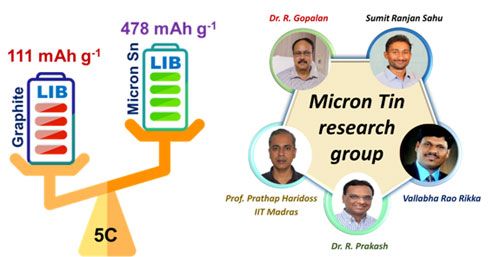 Scientists at the International Advanced Research Centre for Powder Metallurgy and New Materials (ARCI), an autonomous institute under the Department of Science & Technology have developed low-cost micron Tin based anodes which proved to be high-performance and stable anode material for Lithium-ion batteries (LIBs) used in electric vehicles.
Scientists at the International Advanced Research Centre for Powder Metallurgy and New Materials (ARCI), an autonomous institute under the Department of Science & Technology have developed low-cost micron Tin based anodes which proved to be high-performance and stable anode material for Lithium-ion batteries (LIBs) used in electric vehicles.
Electric vehicle (EV) technology demands LIBs with high energy density, long cycle life, and fast charging capability. Existing LIBs use graphite as an anode due to its low operating potential with respect to lithium, high thermal conductivity, and minimal volume expansion (12%) during charge/discharge cycling. However, they have a moderate capacity (372 mAhg-1) and limited fast-charging capability. Tin (Sn) with its low-cost high capacity (993 mAhg-1) and fast charging capability is considered a replacement for graphite anodes in LIBs.
The electrode preparation for LIBs involves coating of slurry of the material on to a metallic foil in a roll-to-roll fashion. In the process of fabricating Sn-based anode, the slurry has to be made using micron-sized Sn (bulk form) powders. However, usage of micron-sized Sn is not recommended due to its high-volume expansion (300%) during charge/discharge cycling, as it leads to cracking of electrodes and drastic erosion of capacity within a few cycles. To circumvent such high-volume expansion, nano-size Sn has been used in various studies, which showed a significant enhancement in the cyclic stability. But, it involves a cost-intensive synthesis methodology and low production yields. Switching from nano-Sn to micron-Sn could result in significant cost reduction of the electrode fabrication process almost by 20 times.
In their recent work published in the journal Energy Technology, the scientists at ARCI took up the challenge of making micron Sn usable for anode fabrication and succeeded in reporting for the first time that the commercially available low-cost, micron-sized Sn (10 μm) is a high-performance and stable anode material for LIBs. A novel, environmentally benign, and low-cost aqueous binder carbonyl-β-cyclodextrin (CCD) was developed by the team and used in the electrode fabrication. The slurry for the Sn electrode was prepared using Sn, CCD binder, and carbon black with water as solvent and was dried under vacuum to obtain the final electrode. Due to the typical cage-like structure of CCD, it establishes strong, multidimensional contact-points with the Sn particles. Thus, it acts as a buffer against high volume expansion of Sn during charge/discharge cycling and prevents the cracking of electrodes.
The micron Sn anode fabricated by the ARCI team delivered nearly two times higher capacity (532 mAhg-1) than that of the conventional graphite anode (330 mAhg-1) at a given current rate of 1C and four times capacity at higher current rate (5C). In addition, the electrode exhibited a cycle life of >1500 cycles with a capacity retention more than 85% proving the suitability of the Sn anode for fast charging application like EVs.
Publication links:
https://onlinelibrary.wiley.com/doi/abs/10.1002/ente.201900849
(https://www.internationaltin.org/micron-tin-powder-makes-cost-effective-lithium-ion-batteries/).
For more details, Dr R. Prakash (rprakash[at]arci[dot]res[dot]in) can be contacted.


























